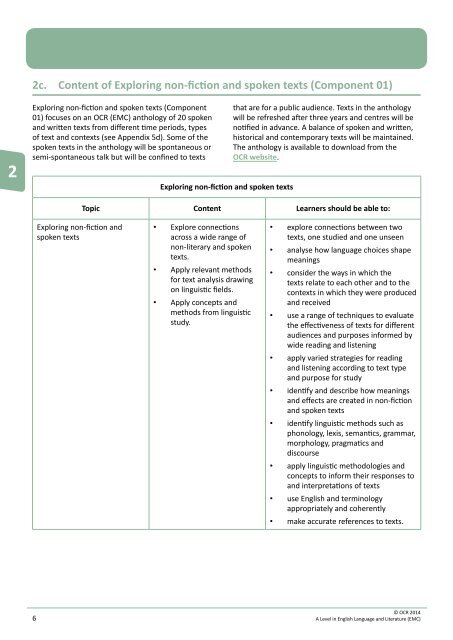171202-specification-accredited-a-level-gce-english-language-and-literature-h474
171202-specification-accredited-a-level-gce-english-language-and-literature-h474
171202-specification-accredited-a-level-gce-english-language-and-literature-h474
Create successful ePaper yourself
Turn your PDF publications into a flip-book with our unique Google optimized e-Paper software.
2c. Content of Exploring non-fiction <strong>and</strong> spoken texts (Component 01)2Exploring non-fiction <strong>and</strong> spoken texts (Component01) focuses on an OCR (EMC) anthology of 20 spoken<strong>and</strong> written texts from different time periods, typesof text <strong>and</strong> contexts (see Appendix 5d). Some of thespoken texts in the anthology will be spontaneous orsemi-spontaneous talk but will be confined to textsExploring non-fiction <strong>and</strong> spoken textsthat are for a public audience. Texts in the anthologywill be refreshed after three years <strong>and</strong> centres will benotified in advance. A balance of spoken <strong>and</strong> written,historical <strong>and</strong> contemporary texts will be maintained.The anthology is available to download from theOCR website.Topic Content Learners should be able to:Exploring non-fiction <strong>and</strong>spoken texts••Explore connectionsacross a wide range ofnon-literary <strong>and</strong> spokentexts.••Apply relevant methodsfor text analysis drawingon linguistic fields.••Apply concepts <strong>and</strong>methods from linguisticstudy.••explore connections between twotexts, one studied <strong>and</strong> one unseen••analyse how <strong>language</strong> choices shapemeanings••consider the ways in which thetexts relate to each other <strong>and</strong> to thecontexts in which they were produced<strong>and</strong> received••use a range of techniques to evaluatethe effectiveness of texts for differentaudiences <strong>and</strong> purposes informed bywide reading <strong>and</strong> listening••apply varied strategies for reading<strong>and</strong> listening according to text type<strong>and</strong> purpose for study••identify <strong>and</strong> describe how meanings<strong>and</strong> effects are created in non-fiction<strong>and</strong> spoken texts••identify linguistic methods such asphonology, lexis, semantics, grammar,morphology, pragmatics <strong>and</strong>discourse••apply linguistic methodologies <strong>and</strong>concepts to inform their responses to<strong>and</strong> interpretations of texts••use English <strong>and</strong> terminologyappropriately <strong>and</strong> coherently••make accurate references to texts.6© OCR 2014A Level in English Language <strong>and</strong> Literature (EMC)


